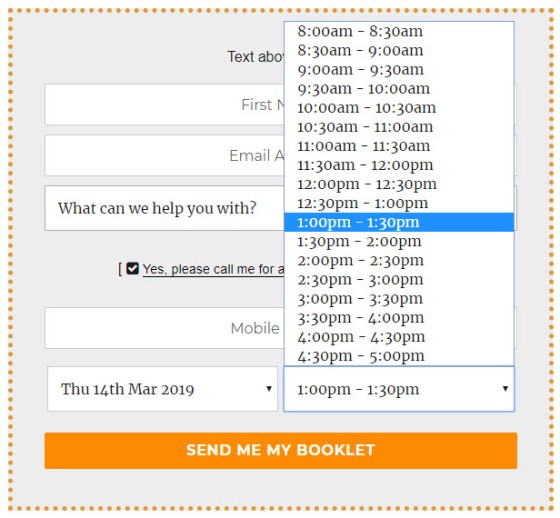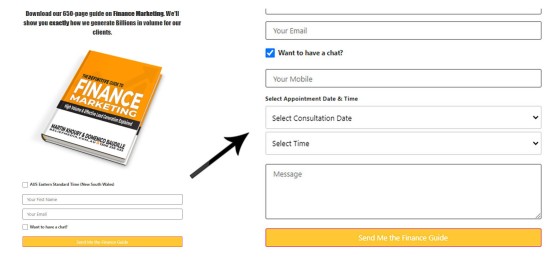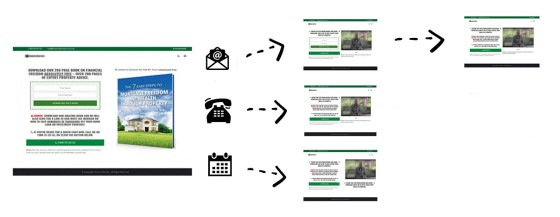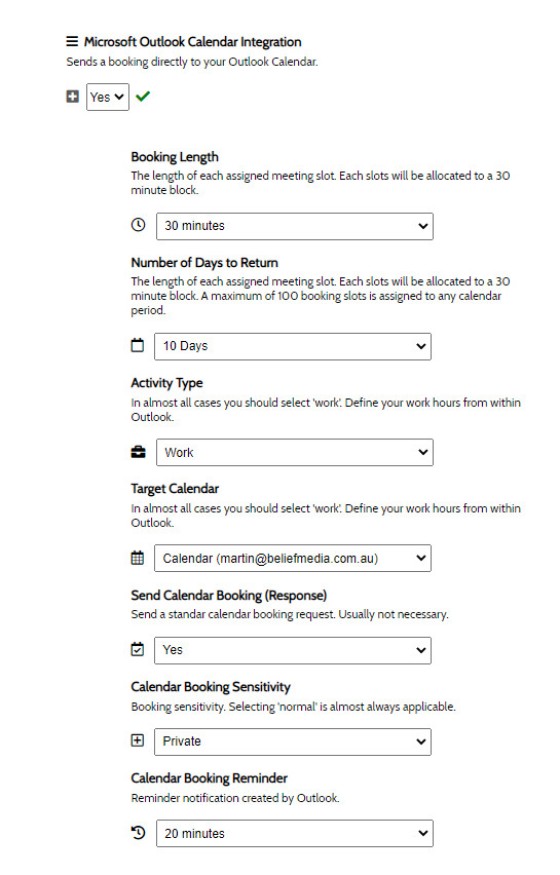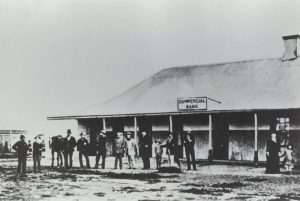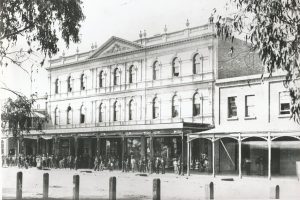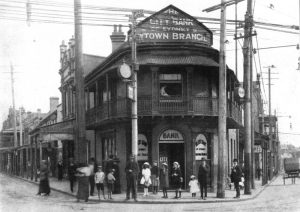The number of brokers we see with off-site and lower-performing calendar services is staggering. Even worse, we see businesses try and integrate off-site calendars into their websites with what is a funnel-debilitating and conversion-blocking exercise. Conversions need to be made simple, and they need to be everywhere. This article simply introduces why a calendar option is essential as part of an integrated digital experience  , and an absolute necessity for a high converting funnel journey.
, and an absolute necessity for a high converting funnel journey.
If you've read anything else on this website you'll recognise the repetition... and this isn't an accident. We figured if we repeated a number of important points the industry would start to recognise their fractionalised marketing, and they'd start to identify why their always-important online lead generation systems are potentially flawed. Sometimes it feels like trying to assign value to relationship and organic lead-generation methods (to a closed-off mindset) is the marketing equivalent of trying to refinance a reluctant borrower out of a seriously costly loan into a lower, better structured product. There are dozens of reasons your website doesn't work, and what we're introducing here is just one of them.
First, we recognise why marketing agencies will introduce lower-performing systems to your business: they simply don't have the internal capacity to build their own higher-performing technology... so they're just peddling the only poor solutions available to them. It's the same reason you'll see Facebook Marketers recklessly introducing Lead Pages, Click Funnels, Kartra, and other low-performing or funnel-destroying applications to their clients. What we're showing you is a high-performing integrated solution that simply performs better, returns more leads, and is 100% guaranteed to convert more business. An integrated calendar is just one small but important part of the conversion equation.
We'll address why the calendar is important to include with virtually any form you on your website, and in particular, those included as part of a landing page subscription.
What is Meant by Integration?
A large number of Yabber  services are integrated with the Microsoft 365 environment, such as email, Planner, Teams, Tasks, and of course your calendar. Unlike third party services, your client booking interactions won't rely on having a user visit a specific part of your website to view a booking form or, even worse, they'll never be sent to an off-site resource (you should never send a user off-site website - your efforts should be directed at getting people on your website, then keeping them there). Instead, the Yabber calendar appears wherever you want it, and however you want it (shown, hidden behind a checkbox... or not at all) - and it's fully integrated. Once a user provides the necessary details, the booking is made in your Outlook calendar. Dates shown on the calendar form are those that you make available via your own Outlook calendar options.
services are integrated with the Microsoft 365 environment, such as email, Planner, Teams, Tasks, and of course your calendar. Unlike third party services, your client booking interactions won't rely on having a user visit a specific part of your website to view a booking form or, even worse, they'll never be sent to an off-site resource (you should never send a user off-site website - your efforts should be directed at getting people on your website, then keeping them there). Instead, the Yabber calendar appears wherever you want it, and however you want it (shown, hidden behind a checkbox... or not at all) - and it's fully integrated. Once a user provides the necessary details, the booking is made in your Outlook calendar. Dates shown on the calendar form are those that you make available via your own Outlook calendar options.
Pictured: A simple example of the integrated calendar option (the formatting has changed a little since the screenshot was taken, but we have a live example at the bottom of this page). Once a date is selected, the second field will populate those dates you have made available from within your Outlook calendar. This simple subscription form now provides more functionality than most landing pages... and you're showing it everywhere; if somebody has read your article we assume they're interested in what you're writing about - it's the perfect time to make an offer. A calendar option such as this provides the necessary functionality to show hundreds, or even thousands, of conversion opportunities all over your website - don't limit them to just one page! Every page on your website needs to provide a lead magnet with associated conversion opportunity. We cannot overstate the explosive effect this simple measure will have on your booking schedule. The calendar options are described in our article on website form creation (in this example we've selected 30-minute booking slots). Form creation makes numerous automation-based options available, including additional fields.
The 'integrated' part of this experience is that the calendar is (optionally) included on any and every form on your website, and we advocate that a form itself be included on every page of your website (since every page on your website is a type of landing page). Why force a new page view for a basic conversion?
Our default and complimentary client website has your single blog posts structured in a very 'naked' manner - not totally unlike landing pages; we don't include a sidebar, and we keep the screen quite white. The idea here is that your high-quality blog post, video, or whatever else - espousing your expertise and authoritativeness - is often enough to command the attention of your reader. If we provide a lead magnet ("offer"), or a subscription experience of some other kind, your audience is far more likely to engage with your marketing asset. Bottom line: when your subscription form presents an easy-to-use funnel entry point into your Prospect pipeline, a user is far more likely to take the plunge.
Pictured: An example calendar (hidden) with image and text associated with the download. The form creation process allows you to fully customise the appearance of the form.
Does it work?
Yes. Without question. We routinely assess the Page Subscription Ratio (PSR) to determine the effectiveness of each page conversion, and that across your entire website (this data is introduced in more detail in an article that introduces our extremely comprehensive website statistics). We've accrued compelling and conclusive data from years of applied experience that provides definitive (and, quite frankly, rather obvious) evidence that this simple on-page calendar and/or subscription experience converts far higher than simply providing a link to a booking page. Remember, third-party booking pages are often enough to scare away potential prospects because they often ask too much information or provide too much of a barrier... and we've seen bounce-rates from these resources that'd shock you into never using them again. Any keystroke, page-view, question, or effort above that is absolutely required will cost you conversions.
Landing Pages and Conditional Redirections
When a user visits your entry landing page for the first time there’s a good chance they’re genuinely interested in your service and want to make first contact by way of a booking or phone number. Does your landing page provide this immediate option? However, we've been able to multiply the effectiveness of landing pages by way of that first page calendar form - our super-simple integrated calendar makes a massive, immediate, and measurable difference.
As discussed in far more details in an article titled "Landing Page, Panel, and Form Conditional Redirections Explained – Improve Your Conversions", applying a calendar on the entry page performs two very important functions:
- It enables first contact if that is what is required from the page visitor.
- Based on the subscription action - basic subscriber, phone subscriber, or calendar booking - we can serve a second page that is far more relevant and far more likely to convert. The second page is the marketing God's gift to your funnel - don't waste it! The second page has two primary functions: convert or escalate... and they should never be used on the same page (at least on landing pages), so conditional redirects allow us to create highly crafted funnel pathways based on known user interactions.
Keep in mind that a landing entry page must always be behind a checkbox - you should never, ever have an open calendar on an entry page because it will decrease conversions (this explains our cryptic article title). For a few years I was personally reluctant to provide even a checkbox calendar on an entry page until we ran it through a few hundred thousand conversions so we could accurately assess its suitability, and I'm glad we did. The effect of this single feature cannot be overstated - it's extremely powerful (much of this value comes from the always-important second page... although you are guaranteed more calendar conversions overall).
Pictured: Conditional landing page redirections are predicated on including a calendar (hidden) on the first entry page. The conditional redirections are a simple way in which to explode conversions. The calendar on the first page isn't intrusive when it's hidden and integrated. Conditional redirections are an option - you may redirect to a single page, split pages, or anywhere else.
Our landing pages accomplish in one page what takes others four or five pages to achieve. This is part of the reason they're so powerful and why they convert more clients.
Pictured: Form Creation Calendar Options. The calendar is part of an optional and very extensive automation schedule. Note that the form creation process includes immediate text message notifications to broker and client, and a booking reminder SMS message for the client. The form creation process is described in an article titled "Creation Email Subscription Forms in the Yabber Marketing Platform".
Conditional form redirections are available on any form anywhere on your website (although for standard 'every page  ' blog post forms we tend to keep the user on the same page). The conditional methodology is a small part of a much bigger conditional and escalating ideology applied across all your on-site and off-site marketing, and it's a methodology we apply everywhere; our methods will provide you with a clear online tactical advantage over your competition. The conditional methods are truly essential for a real marketing funnel - the calendar benefits represent just one small part.
' blog post forms we tend to keep the user on the same page). The conditional methodology is a small part of a much bigger conditional and escalating ideology applied across all your on-site and off-site marketing, and it's a methodology we apply everywhere; our methods will provide you with a clear online tactical advantage over your competition. The conditional methods are truly essential for a real marketing funnel - the calendar benefits represent just one small part.
Conclusion
"A calendar conversion on every page of your website" - you would think that in this day and age this simple proposition wouldn't be so alien and difficult to achieve, yet our experience with just about everybody is that it just doesn't happen. Our fully integrated Yabber Suite  (the only integrated and full stack digital product available to the industry) makes this process an exceedingly simple drag-and-drop experience (in fact, as discussed in an article titled "Include Subscription Forms on Every Page of Your Website", we detail how a single selection within Yabber creates a default and global subscription and calendar form under every blog post, with the option of setting page-specific forms via the SEO panel). It stands to reason that if you have a dedicated calendar booking form on your website rather than sending a user to a third-party website or service (potentially riddled with ads or distractions) you're more likely to see results.
(the only integrated and full stack digital product available to the industry) makes this process an exceedingly simple drag-and-drop experience (in fact, as discussed in an article titled "Include Subscription Forms on Every Page of Your Website", we detail how a single selection within Yabber creates a default and global subscription and calendar form under every blog post, with the option of setting page-specific forms via the SEO panel). It stands to reason that if you have a dedicated calendar booking form on your website rather than sending a user to a third-party website or service (potentially riddled with ads or distractions) you're more likely to see results.
An on-site calendar option that you might link to from an email signature or elsewhere provides deeper marketing options such the inclusion of video, or other downloadable resources, which will attract the user deeper into our marketing funnel experience. Again, you're sending your audience to your own integrate resource and not somebody else's website.
The notion that some marketers will ignore PSR data is somewhat offensive to us; how can you determine what material is 'trending' or popular on your website unless you can conclusively determine what pages are converting more than any other? It's a simple measurement but one we've seen many ignore. Please, we implore you, act upon your data-driven insights and build a simple agile framework upon which you can quickly respond to market needs. Your business will thank you for your efforts.



